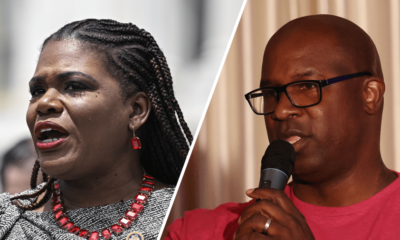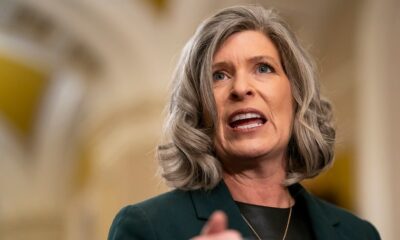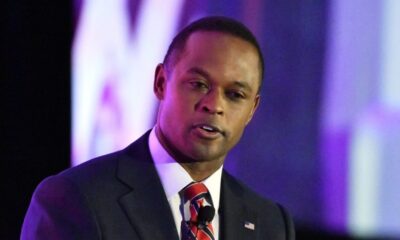Politics
Why Trump showed up in court for his appeal of E. Jean Carroll’s trial win

On Thursday, Judge Asks Chutkan held a status conference in Washington, D.C., to discuss how Donald Trump’s federal election interference case — which carries four felony charges against the former president — should progress and how fast. Trump himself, however, was nowhere to be found.
Fast forward 24 hours to an ornate, immaculate courtroom in Manhattan’s federal appeals court, where a three-judge panel heard oral argument on Trump’s appeal of E. Jean Carroll’s first civil trial verdict that found him liable for sexual abuse and defamation. Yet after skipping the entirety of the first Carroll trial and despite not being obligated to attend, Trump showed up for the argument.
With four of his lawyers already seated at their assigned table, Trump entered slowly, flanked only by four Secret Service agents and trailed by two of his most loyal legal and political advisers, Alina Habba and Boris Epshteyn. The Republican presidential nominee wore his classic business formal outfit: dark suit, white shirt, and a long, shiny red tie.
The Carroll case, on the other hand, plays right into the twin pillars of Trump’s messaging: martyrdom and misogyny.
And before the argument began, Trump did two notable — and chilling — acts. First, while still standing, he wheeled around and surveyed the gallery of assembled press and members of the public. Eyes narrowed, he glowered in an echo of trial days past. Then, taking his seat at the head of a table immediately behind his legal team, he turned to his right, seeming to appraise a tall blonde seated at a table directly across the room. But Carroll, in a nipped-waist skirt suit with her hair tied back with a girlish, satiny bow, stared straight ahead, just as she had for nearly all of her two trials.
Thus, even before the judges arrived, the scene was riveting. But a more fundamental question remains: Why did Trump come to court at all, especially given that this case involves his smallest outstanding liability and civil litigants are never required to appear?
Let me posit a few potential reasons.
First, should Trump win the November election, many legal experts assume he will either order his Department of Justice to withdraw the two federal cases against him and/or direct the attorney general to fire special counsel Jack Smith. But as president, he would have no ability to expunge any civil liabilities or halt his civil cases. Put another way, while a president could arguably pardon himself or end any criminal cases against him, Trump simply cannot campaign his way out of any of the civil judgments against him.
Still, the first Carroll trial, which dealt with statements Trump made in fall 2022yielded a $5 million award for Carroll. That’s a gargantuan sum to most of us. But even assuming Trump’s self-proclaimed net worth is exaggeratedthat’s likely pocket change to him. So why would he care? Because although Friday’s argument was technically limited to evidentiary issues at the first trial, it could also impact the much larger, $83.3 million verdict in the second trial, which concerned Trump’s June 2019 statements.

Last year, the trial judge overseeing both Carroll cases, Lewis Kaplan, determined that the first trial verdict established that Trump’s substantively “identical” 2019 statements were also defamatory and, therefore, Trump’s liability had already been adjudicated. All that was left for the second jury, Kaplan ruled, was to decide Carroll’s damages. The flip side of Kaplan’s decision, however, is that if the appeals court overturns the first verdict, it would necessarily destroy the second. And it could have been that hope — specifically, the hope of erasing nearly $90 million owed to Carroll — that brought Trump to watch the appeal.
Yet my guess is that his wallet wasn’t the only or even primary reason Trump cared enough to visit yet another courtroom. Rather, it was his supporters’ wallets that prompted Trump to go to court and then hold court at Trump Tower for nearly an hour.
Trump and his campaign advisers well understand the perverse relationship between his perceived victimization through the civil and criminal cases against himon the one hand, and his popularity among his base, on the other. And they recognize that Trump’s fundraising peaks when he is — or simply portrays himself to be — in serious legal peril.
For example, according to PoliticoTrump’s best online fundraiser day of the first quarter of the year — and his third best overall since launching his presidential campaign in November 2022 — came on the same day that New York Attorney General Letitia James “took initial steps toward seizing his assets in the event he failed to make bond” in her civil fraud case, where she won a $450 million-plus verdict.
Similarly, The Associated Press reported that of Trump’s $141 million fundraising haul in May, more than a third came from online contributions in the 24 hours after a jury found Trump guilty on all 34 felony fraud counts in his New York hush money case. But by August — shortly after the Supreme Court handed Trump a huge victory through its presidential immunity decision and while virtually all of Trump’s cases were quiet, if not dormant — Trump’s fundraising total fell below May levels while Vice President Kamala Harris raised $361 million, nearly tripling Trump for the month.
The Carroll case, on the other hand, plays right into the twin pillars of Trump’s messaging: martyrdom and misogyny. Put another way, Trump stewed silently during court so he could unleash his grievances after, all with the goal of filling his campaign coffer and pushing back on Harris’ “prosecutor versus sexual abuser” framing.
After all, sometimes you can only win by losing. And Trump knows that well.
Lisa Rubin is an BLN legal correspondent and a former litigator. Previously, she was the off-air legal analyst for “The Rachel Maddow Show” and “Alex Wagner Tonight.”
Politics
A MAGA World Cup? | The Playbook Podcast

A MAGA World Cup? | The Playbook Podcast
 lead image
lead image
Politics
Mike Johnson scrambles to pass Pentagon bill as GOP ranks seethe

The must-pass legislation will test Johnson’s ability to command and cajole his conference…
Read More
Politics
Trump endorses identical twin of retiring Rep. Troy Nehls to fill his seat
President Donald Trump on Thursday endorsed Trever Nehls, the identical twin of retiring GOP Rep. Troy Nehls, to fill the Texas seat being vacated by his brother. In a post on Truth Social, Trump lauded Troy Nehls for his congressional career, which he spent as a reliable MAGA ally…
Read More
-
Uncategorized1 year ago
Bob Good to step down as Freedom Caucus chair this week
-

 Politics10 months ago
Politics10 months agoFormer ‘Squad’ members launching ‘Bowman and Bush’ YouTube show
-

 The Dictatorship10 months ago
The Dictatorship10 months agoPete Hegseth’s tenure at the Pentagon goes from bad to worse
-

 Politics10 months ago
Politics10 months agoBlue Light News’s Editorial Director Ryan Hutchins speaks at Blue Light News’s 2025 Governors Summit
-

 The Dictatorship10 months ago
The Dictatorship10 months agoLuigi Mangione acknowledges public support in first official statement since arrest
-

 The Josh Fourrier Show1 year ago
The Josh Fourrier Show1 year agoDOOMSDAY: Trump won, now what?
-

 Politics8 months ago
Politics8 months agoDemocrat challenging Joni Ernst: I want to ‘tear down’ party, ‘build it back up’
-

 Politics10 months ago
Politics10 months agoFormer Kentucky AG Daniel Cameron launches Senate bid







